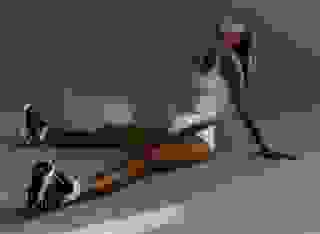- Romance
- The Curse of the Aztecs
Note: You can change font size, font face, and turn on dark mode by clicking the "A" icon tab in the Story Info Box.
You can temporarily switch back to a Classic Literotica® experience during our ongoing public Beta testing. Please consider leaving feedback on issues you experience or suggest improvements.
Click hereArchaeology has consumed me since the world history class I took in high school. What grabbed my attention was the recounting and pictures of various archaeological digs in Europe, The United States, and Mexico. Archaeologists had been able to piece together the lives and religion of early peoples by digging up their homes, burials, and middens.
After that history class, I spent my free time reading everything I could find in the library about archaeology, and by the time I was a senior, had decided archaeology would be my life's work.
That required a PhD in Archaeology if I was to be considered more than just an amateur, and after seven years of study, I submitted my PhD thesis describing my conclusions about early Native American religious culture after reviewing the evidence I obtained at a dig of a village site in Montana. My thesis was accepted, published, and later that year, I donned the mortarboard and gown of a professor and was awarded my degree. I was proud of the diploma that conferred to me the title of Dr. Tom Reynolds, Doctor of Archaeology
The next fall, I accepted a teaching position at the University of Illinois in Chicago. While this position sufficed to furnish an income, I knew I would drift off into the obscurity of academia if I did not continue to do research and publish articles in the various publications about archaeology To this end, I began researching the Aztec civilization.
Cortes conquered the Aztecs with one goal in mind -- to bring as much gold as he could find back to Spain. As a result, most of the contemporary writings were about military actions and the search for gold. Most written Aztec records were destroyed by the Spanish as being counter to the Catholic religion, and what few Spanish records that do exist are tainted by that same religion. Little was recorded about the Aztec way of life, and that would be the topic of my first paper as a full professor.
Not a lot of current data about the Aztec civilization existed in the published literature either. This was for one simple reason -- the rain forests of Central Mexico had quickly swallowed up the cities once the Aztecs fled the attacks by Cortes or died of the diseases the Spanish brought with them. It is difficult to study something if you can't find it.
A few cities had been found, most of which were the current sites of major cities in Mexico, but the descriptions in the Spanish texts spoke of many, large cities further into the interior which contained vast amounts of gold. Were I able to locate even one and excavate even a small portion, I'd have material about which to write and publish, and further excavations of even one site could provide me enough material for an entire career.
In doing my research, I came across the name of the Friar who accompanied Cortes as the chaplain of the expedition, one Fr. Bartolemé de Olmedo of the order de la Merced. Via the Internet, I was fortunate enough to find a copy of a letter he sent to the Abbot of his monastery. Of particular interest to me was Fr. Olmedo's recounting of Cortes' meeting with and subsequent relationship with Cuauhtemoc, the last known ruler of the Aztecs, in the city of Tenochtitlan, now the center of Mexico City.
According to Cortes, he conquered Tenochtitlan in 1521 and captured Cuauhtemoc while he was fleeing across Lake Texcoco with his wife and family. Cortes was so impressed by the young ruler's bravery in battle he did not kill him, but released him to go where he might.
Cortes then searched Tenochtitlan for the gold he believed to be there, but found less than he had anticipated. He subsequently recaptured Cuauhtemoc and tortured him in an attempt to learn the location of the gold of which he had been told by native informants.
Apparently Cuauhtemoc did give Cortes the information he sought, but Cortes kept Cuauhtemoc captive while he searched for the gold. It was during his search Cortes learned of a plot by Cuauhtemoc and two other minor Aztec rulers to kill him. As punishment, Cortes hanged all three in public as a lesson to any other would-be resistance.
During the hanging, Cortes became aware Cuauhtemoc's brother was attempting to incite the city residents to war. As Cuauhtemoc was the last of the three to be hanged, he was still strangling, but not yet dead. Cortes cut down Cuauhtemoc to avoid the uprising, and Cuauhtemoc lived.
Here is where the accounts begin to differ. Cortes' account reports Cuauhtemoc survived only a few more days and then died and was buried at Ixcateopan in the state of Guerrero.
Fr. Olmedo's version of the story was that Cortes agreed to allow Cuauhtemoc to leave the area under the threat of execution should he return. Cuauhtemoc left with his wife and family and went deep into the rain forest to a large city named Ixtlilxóchitl.
Fr. Olmedo believed Cuauhtemoc fled to Ixtlilxóchitl because he did not trust Cortes. The city was the location of a large repository of gold and was guarded by an elite force of Aztec warriors deemed too valuable to be lost fighting the usual battles with Cortes. He and his family would likewise be protected by these same warriors.
The location of the city was a closely guarded secret even among the Aztec rulers. Fr. Olmedo learned of it's location by sending a native assistant to secretly follow Cuauhtemoc's party because he had heard rumors of gold in the city and had other plans for that gold. He recorded the distance and directions in his letter to the Abbot in hopes the Abbot could arrange for another expedition to recover the gold for use by the monastery. As far as I could determine, that expedition did not happen.
Fr. Olmedo's story was more than plausible to me. Cortes was known for his lack of respect for the Aztecs. In one day, his soldiers slaughtered three thousand of them under his orders, yet he respected Cuauhtemoc enough to free him after capture the first time and might have done so again. Since Cortes had more than enough troops left to easily put down any insurrection by the remaining Aztecs, he had no real reason to save Cuauhtemoc's life in order to stave off another battle.
The true reason must have been his respect for the man. He hung Cuauhtemoc as a demonstration of Spanish power, cut him down to spare his life, and then sent him to safety. The story of Cuauhtemoc's death was just to show that even though spared, no man could resist the power of Cortes.
I wrote my research and conclusions into a proposal to the University for a grant to travel to the area, search for the city, and return with such items as I was able to recover. The information would bring fame to both me and to the University.
I was awarded a grant, though only enough for a very small initial expedition. It was promised that should I bring back conclusive proof I had found the city, a larger grant would be forthcoming.
After much planning, I determined I had only sufficient funding to allow one other person to accompany me. As soon as the grant was announced, I advertised for and received over twenty applications for the job of my assistant. Most were students working on a master's thesis who wanted some field experience. A couple were PhD candidates, but I didn't interview them. They were far enough along in the field to find a larger expedition fitting their subject of research.
I had looked over six applications and rejected them all when I found the application of Elena Mendez and I was pleased. As they say, "There is no greater joy in teaching students than to see the light come on in their eyes". Most students work hard and do well, but one can tell they are just learning by rote. Elena was the opposite. I had taught her in three classes, and in each, she delved into the subject matter as if it was knowledge that sustained her life. I saw that light in her eyes after nearly every lecture.
Elena also had skills I believed would be invaluable in my quest. I read Spanish, though slowly, and I do not speak it well at all. Elena was born in the US after her parents had immigrated here from Mexico, and she grew up speaking both Spanish and English.
The third reason for choosing Elena was her chosen field of study. Her reason for applying was to further her studies in the language of the Aztecs as the peculiarities of the language was to be the topic of her master's thesis. As she said when I interviewed her, the various pronunciations of the Aztec vowels and consonants had been described, but the syntax was still a mystery. If we were successful in locating Ixtlilxóchitl or any other ruins, she would copy the pictographs and use them in an attempt to determine the rules for the syntax of the language.
I confess there was a fourth reason as well, that being that Elena was quite a stunning woman. I did not let her prominent breasts, wide sensuous hips, long shining black hair and soft facial features influence my decision until after her interview, but those features did cement my decision. It would be more pleasant slogging through the rain forest with a beautiful young woman than with a sweating, cursing man.
We flew into Mexico City and stayed two nights at The Presidente Intercontinental in order to arrange transportation, a guide, and men to set up camp and carry supplies. I put our passports and my money in the hotel safe so they would not be lost or stolen on our expedition.
Alejandro, the guide I'd hired, drove us in his truck to our starting point at the ruins of Itzamkanac in what is now the Mexican state of Champece. According to Fr. Olmedo's recounting, that was the point at which Cuauhtemoc and his family walked into the rain forest. We would begin at the ruins of the city and follow Fr. Olmedo's directions for the two weeks I calculated it would take to reach the city.
I had engaged the services of four men to carry our supplies and a cook to prepare our meals. I would lead the expedition, but Alejandro was there to keep us away from the dangers of which we knew nothing.
We carried hammocks to sleep in because they're lightweight and raise you off the floor of the rain forest. That's keeps the creatures of the night off you and they're pretty comfortable once you get used to sleeping on your back. They were more of a personal tent than just hammock because each had a fabric roof in case it rained during the night and mosquito netting along the sides. Each was somewhat wider than a normal yard hammock, wide enough two could sleep in one if they were very friendly.
The men carrying our supplies always strung our hammocks within a few feet of the fire. They hung their own in a spot some distance from the fire, I suppose to give us some privacy. When I asked Alejandro about that, it was a little difficult for me to understand his Spanish, but it was something to the effect that they wouldn't want anybody watching them have sex with their wives and thought Elena and I wouldn't either. I explained that Elena wasn't my wife, but he just grinned and walked away.
On the tenth day, our guide excitedly returned from his position ahead of us and began jabbering in Spanish. Elena calmed him a little and then translated.
"Alejandro has found a large stone with writing on its surface. We should take a look."
When we arrived at the location, the stone was in actuality a large slab of rock standing upright and embedded in the rain forest floor. Elena examined the pictographs on the stone, and then turned to me.
"The pictographs are Nahuatl. It says 'yāwa weyaltēpetl tlatoāni' which translates literally to 'go city king'. I think this means 'this way to the city of the king'."
That stone encouraged me.
"This may be leading us to Ixtlilxóchitl, the city I'm looking for. According to my research, it was the last refuge of the last ruler of the Aztecs. Let's keep going and see if we can find anything that will tell us for sure."
Later that day, we arrived at a tree and vine covered hill which proved very difficult to climb owing to the steep slope of the sides. After two hours of pulling ourselves up by using the small trees and the vines that grew between them, we arrived at the summit and stopped to rest.
As I looked down the path up which we had come, I was thinking the steep slope could not have occurred naturally. Over the past days, we had come to many rises in the ground, but all were flatter in slope. This was the result of the inability of the soil to resist movement caused by the heavy rains that pelt this area during the wet season. Any steep slope would long ago have been flattened by erosion, and yet, this hill still stood. Something must be under the soil and holding it in position.
I looked over to where Elena lay on her back to tell her of my thoughts, but had to pause. I knew the climb would have been more strenuous for her than for me because she was a typical female, soft and slender without much muscle mass. I was wringing with sweat in the heat, and so was she.
In the open collar of her shirt I could see beads of sweat on the swell of her breasts, and there was a dark stain on her khaki shirt that covered the material over her breasts and then continued on down her belly to her pants. That same dark stain was present from her waistline in a vee shape that disappeared between her thighs. Those stains, while not exactly erotic, stirred my imagination to envision the curves that lay beneath that stained fabric.
Elena saw me looking and smiled.
"I must look a mess."
"No, you just look tired and sweaty."
She smiled.
"I am. I'd give a hundred dollars right now for a shower. I don't suppose you have one in your backpack, do you?"
"No, but we crossed a stream a while back. The water looked clear to me, so maybe that would work."
Elena let her head fall back to the ground and sighed.
"I'd just get all sweaty again coming back up this hill. How come it's higher than any we've had to climb before?"
I stood up and moved to sit down beside Elena.
"I don't know except that there has to be something under the topsoil to keep it in place. I'm going to dig down a little and see what it is. It's probably just a rock formation. That's what was under the last one. It just wasn't as high."
The topsoil was mostly decayed vegetable matter so it was easy to dig with my trowel. I dug down about six inches before my trowel hit stone. After enlarging the hole somewhat, it looked to me as if the stone was flat. Flat stones never occur in nature. A naturally broken stone will have a significant curve to the surface called a conchoidal fracture, but this looked as flat as a brick. I kept excavating and that didn't change. What did change was the pictograph that I uncovered and my heart rate jumped when I realized what it was. The pictograph was the start of a word in Nahuatl.
I called to Elena to come have a look. When she bent down to peer into the shallow hole, she caught her breath.
"Keep uncovering it so I can see the rest."
Half an hour later, Elena used her fingertips to brush that last of the soil from the engraved letters and then nodded.
"It says "īxtli kostik tēomeh nik ēstli titlāni", literally - "face yellow gods to blood send ". I've seen similar wording before in pictures of the temple ruins at Tenochtitlan. It was on the platform where human sacrifices were performed. I think it means here was where they sacrificed their victims. I don't know what 'face yellow' means."
I shook my head.
"This hill isn't high enough to be an Aztec temple. They're enormous structures -- built high to reach the Gods. They wouldn't think this would be close enough to the Gods."
"Well, who else would have sent blood to the Gods?"
I said I didn't know but that we'd spend a couple of days here to see if we could find any more clues that might tell us. As I'd done every night we camped, I sent two of the native porters back down to the stream to fill the big canvass water bag we carried while the guide built a tripod to hold it. Once they brought back the water and hung the bag from the tripod, I tossed in the right number of water purification tablets and then told Elena it would be safe to drink in about an hour.
She grinned.
"It'll be safe enough to wash with right now, won't it?"
When I said it would, she filled a small canvas bucket she took from her backpack, shouldered her backpack, and then walked off into the trees until I couldn't see her.
She came back about half an hour later while our cook was preparing our evening meal.
"I feel almost human again. It wasn't a shower, but just washing off the sweat and changing clothes helped a lot. What's for dinner?"
That night, laying in my hammock, I went over what I knew about Aztec sacrifices. Because the sacrifices were considered by Cortes to be a heathen practice, he recorded them in great detail. There was a lot of information out there about the reasons, the ceremony and the process, so I had a lot to think about.
The Aztecs believed the Gods had bled and died to create life, and that in order to sustain life, the Aztecs had to give blood and die. In some cases, the humans sacrificed were war captives, and it was these captives who were killed during the mass sacrifices reported by Cortes and others. More often though, they were people chosen from the local population and went to their deaths willingly.
A willing victim was treated as if he was himself a god, and was well fed and lavished with comforts up until the appointed day. They were also provided with women as lovers. These women were prostitutes who were called "ahuianime" and were closely associated with the Goddess Xochiquetzal, the goddess of flowers, beauty, love, art, and sex for pleasure. They were trained in the traditional arts of women like weaving and pottery, but also in the art of pleasing men with music and art, and of course, sex.
Their association with Xochiquetzal also gave them a role in ritual sacrifices as priestesses. Little was known about how a woman became an ahuianime or what happened to them when they became too old for their assigned tasks.
It was then I remembered reading that the ahuianime painted their faces with yellow dye. Could we be standing on a minor temple to Xochiquetzal? I'd never read of any discovery like that before, but so little was known about the actual life of the Aztecs, it was possible. Other cultures built temples to specific gods.
It was during the second morning of excavating we uncovered several large stone slabs laying side by side on what appeared to be a terrace on the side of the hill. When I brushed away the remnants of soil, each slab was inscribed with more words in the Nahuatl language.
Elena looked at the slabs for almost five minutes and then turned to me with a questioning look on her face.
"These are the graves of prostitutes. Each slab has a name and the word "ahuianime" or prostitute. Why would they take such care to bury a common prostitute?"
"Because these women weren't common prostitutes. They were prostitutes who were given to men before they were sacrificed. They were considered almost goddesses because of their training and responsibilities. I remembered last night they painted their faces with yellow dye, like the inscription stated."
Elena chuckled.
"They must have been some really hot women to be worth being torn apart after a man had sex with them."
I grinned.
"Well, I don't know of any written accounts that could attest to that, but they were trained in how to please men so they probably were."
Elena was looking at the last grave slab, a slab much larger than the others, and she motioned to me.
"Come have a look at this one. It's the same except it's bigger and has some other writing and a pretty elaborate carving. The carving looks like a naked woman with a man, and she has something on her head...sort of like a crown."








